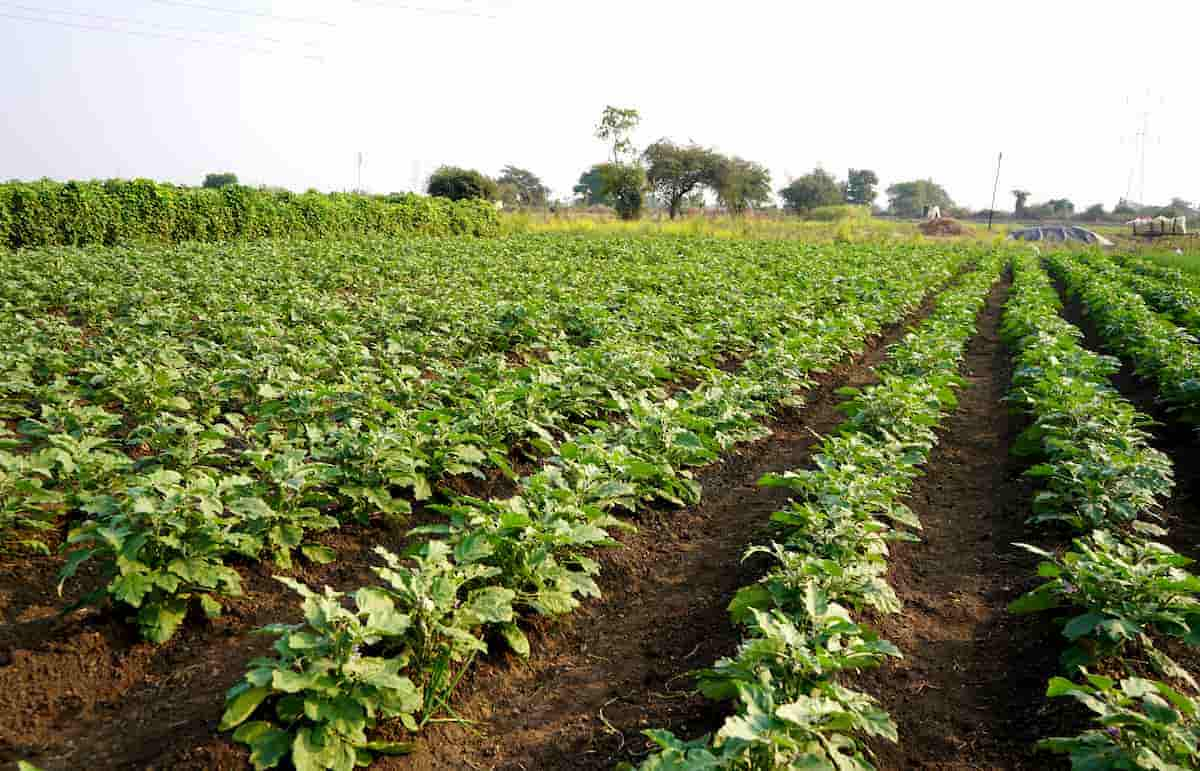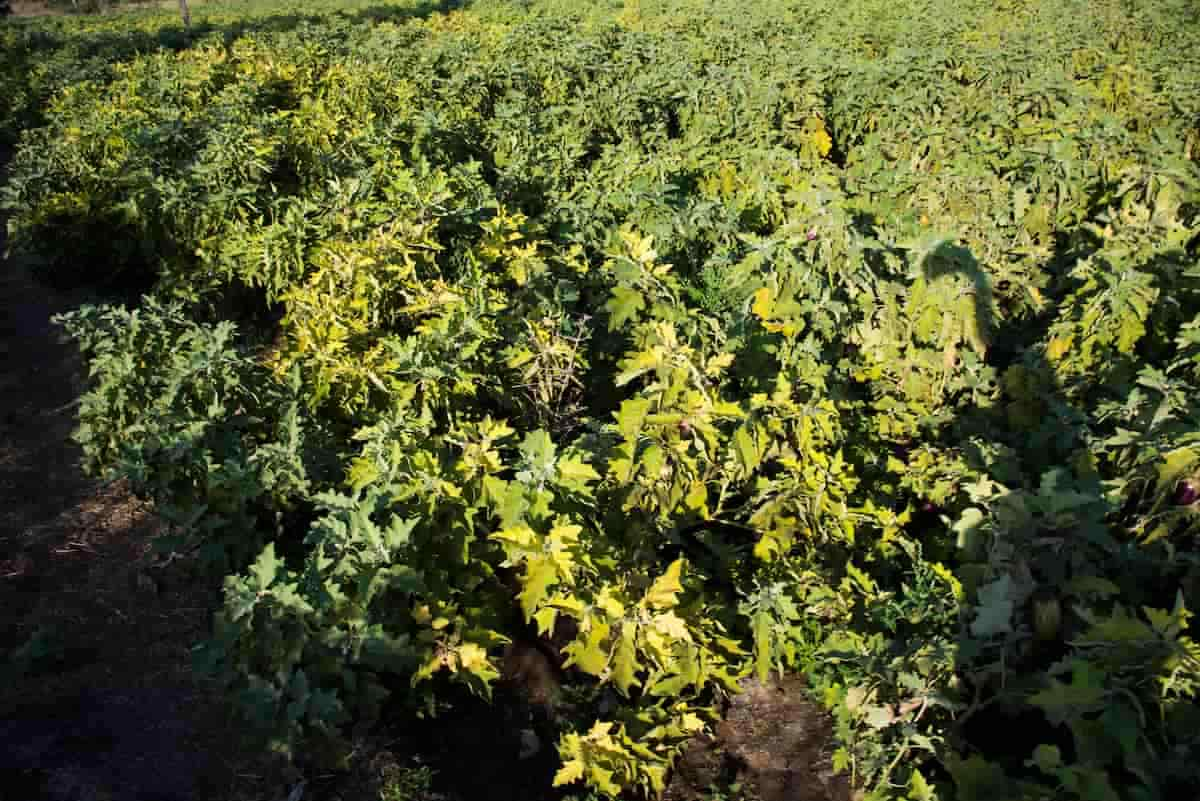Barbella eggplants are also known as Violetta di Sicilia eggplants. It is an Italian variety. Plants that grow about 24 inches (61 cm.) tall produce five to six one-pound (0.5 kg.) fruits. Dark purple skin with white to light pink hues surrounds a dark purple, lightly spiny calyx. Round with deep grooves and creamy white flesh; the fruit looks like a grapefruit or softball. This plant produces eggplants with a diameter of 4 to 6 inches (10-15 cm.) and a sweet, slightly nutty flavor.

Barbarella Brinjal Farming
Climate Required for Barbarella Brinjal Farming
Frost can cause severe damage to brinjal. Its successful production requires a long, warm growing season with a temperature range of 21-28°C. During the cool season, weather conditions, particularly low temperatures, cause abnormal ovary development (splitting), resulting in deformed fruits.
However, late cultivars can withstand mild frosts and continue to bear fruit. During the warm season, brinjal grows lush and starts bearing fruit from the first flowers. However, its growth is slow during the cool season, and its fruit size, quality, and production are reduced.
Soil Requirements for Barbarella Brinjal Farming
Barbarella brinjal can grow in all soil types, from light sandy to heavy clay. Early yields can be achieved on light soils, while higher yields can be on clay-to-loam and silt-to-loam soils. The best soils for brinjal cultivation are loam and sandy soils with normal or higher status. The soil must be fertile and well-drained. It is a hardy crop that can grow even in soil with high pH levels. Brinjal is best cultivated in soils with a pH range of 5.5 – 6.6.
Bed Preparation
Brinjal seeds are sown in nursery beds to grow seedlings for transplantation. Building raised beds in heavy soils is necessary to avoid water logging. Sandy soils, however, can be sown in flat beds. It is necessary to prepare raised beds with a size of 7.2 x 1.2 m and a height of 10-15 cm. A one-acre planting area can be planted with seedlings raised in four such beds.
For watering, weeding, etc., about 70 cm distance is maintained between two beds. Beds should have a smooth, level surface. During bed preparation, the soil can be mixed with well-decomposed FYM or leaf mould. It effectively prevents seedling mortality by drenching the beds with Bavistin (15-20 grams/10 liters of water).
Sowing Barbarella Brinjal Seeds
Seed should be sown thinly in lines spaced 5-7 cm apart. The seeds are sown at 2-3 cm depth and covered with soil, followed by light watering with a water can. After that, it is recommended to cover the beds with straw, grass, or sugarcane leaves to maintain the necessary temperature and moisture.
In case you missed it: How to Grow Eggplants/Brinjal in Greenhouse: A Step-by-Step Guide for Seed to Harvest

Water the seeds as needed until germination is complete using a water can. When the grass or straw cover germinates, it is immediately removed. Water can be lightly withheld from seedlings during their last week in the nursery to help them harden. By the time the seedlings reach 15 cm in height with 2-3 true leaves, they are ready for transplanting after 4-6 weeks.
Transplanting Barbarella Brinjal Seedlings
By giving the field four to five plowings with a sufficient interval between each plowing, the field is plowed to a fine tilth. A plank should be laid to ensure proper leveling. After that, the field is divided into beds and channels. During land preparation, well-decomposed FYM is thoroughly incorporated. Depending on the variety and planting season, the spacing varies.
A 75 x 60 cm spacing for round varieties like Barbarella Brinjal is recommended. In light soils, seedlings are transplanted in furrows, while in heavy soils, they are transplanted along ridges. Three to four days before transplanting, pre-soaking irrigation is given. Seedling roots should be dipped in a solution of Bavistin (2 grams per liter of water) before transplanting. Ideally, transplants should be performed in the evening.
Irrigation Requirements for Barbarella Brinjal Farming
The crop needs to be irrigated according to its needs. The importance of timely irrigation is quite evident regarding good growth, flowering, fruit set, and fruit development. High yields may be achieved when the soil is fertile, and the moisture levels are optimum. During hot weather, irrigation should be applied every third to the fourth day, while during winter, irrigation should be applied every seven to twelve days. When there is no rain, irrigation is given before top dressing. Brinjal fields should be irrigated regularly during frosty weather to keep the soil moist.
Manure and Fertilizers Application for Barbarella Brinjal
Fertilizer doses are determined by the soil fertility and the organic manure applied to the crop. A good yield requires 15-20 tonnes of well-decomposed FYM incorporated into the soil. An optimum yield is achieved by applying 150 kg of N, 100 kg of P2O5, and 50 kg of K2O. Planting is the time to give half of the N dose and the full doses of P and K. The remaining half of the N dose is divided into three equal parts. Split doses are given one and a half months after transplanting, one month after the first application, and three and a half months after transplanting.
Inter-Culture and Weed Control in Barbarella Brinjal Farming
It is important to control weeds as soon as they are seen, either by hand weeding and hoeing or by applying herbicides. Keeping the field free of weeds and facilitating soil aeration and proper root development requires frequent shallow cultivation regularly. Orabanchae sp. is the most serious weed in brinjal.
It is a root parasite that needs to be controlled carefully. In the evening, gaps should be filled, and irrigation should follow. Adding Fluchloralin (400-600 grams per acre) and Oxadiazon (200 grams per acre) to the soil before planting and spraying Alachlor (400-600 grams per acre) on the surface before planting control brinjal weeds.
Harvesting Barbarella Brinjal
It takes about 80-100 days for the Barbarella eggplant to mature. Fruits are harvested in diameter between 4-6 inches (10-15 cm). Once you determine it is time to harvest eggplants, wear gloves, and long sleeves to protect your skin from the prickles on the eggplant stem. Treat eggplants gently when harvesting them since they bruise easily.
In case you missed it: How to Grow Round Violet/Black Brinjal at Home: A Step-By-Step Process

When harvested, a short piece of stem is cut above the calyx (cap) attached to the eggplant’s top. You can use pruners or a sharp knife to make the cuts. A few days to a few weeks may be required to harvest eggplants at their best, and frequent eggplant harvests promote a higher fruit yield.
Conclusion
It is believed that Barbarella eggplant is native to the island of Sicily. Whether grown in an open field or a greenhouse, Barbarella thrives. Compared to other eggplant varieties, the plant is very leafy, contains fewer spines, and will be a vigorous fruiter under ideal growing conditions. Classic eggplant dishes, such as eggplant parmesan, can be grilled, fried, or sautéed. Also ideal for stuffing eggplant, Barbarella can be roasted whole or hollowed out as stuffed eggplant.
- Feed Your Flock for Less: Top 10 Tips to Save on Chicken Feed
- Ultimate Guide to Ossabaw Island Hog: Breeding, Raising, Diet, and Care
- Hatching Answers: The Top 10 Reasons Your Chickens Aren’t Laying Eggs
- Eggs and Economics: Breaking Down the Cost of Raising Backyard Chickens
- Defend Your Greens: Proven Methods to Keep Iguanas Out of Your Garden
- Ultimate Guide to Cinnamon Queen Chicken: A Comprehensive Guide for Beginners
- Ultimate Guide to California Tan Chicken: Breeding, Raising, Diet, Egg-Production and Care
- Ultimate Guide to Marsh Daisy Chicken: Breeding, Raising, Diet, and Care
- 10 Types of Chicken Farming Businesses You Can Start for Profits